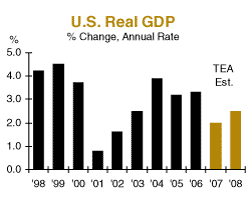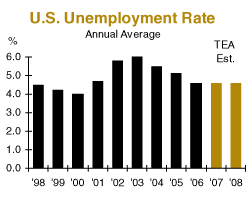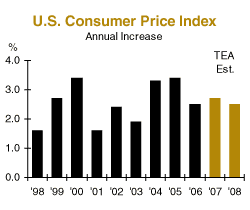|
September 19, 2007 (you may need to refresh your browser to view the latest issue)
Autumn View
Written by Jeff Thredgold, CSP, President, Thredgold Economic Associates
 The American Economy The American Economy
…many, many challenges
The critical question to be addressed in coming months is whether or not the U.S. economy will dip into recession. We suggest about a 40% chance of recession during the next 12 months, with a stronger expectation that a “growth recession” or sluggish growth is more likely.
Real (inflation adjusted) economic growth could slow to a 0.5%-2.0% annual growth pace during the next six months, versus the already sluggish 2.3% real annual growth pace during 2007’s first half. Housing weakness and credit market anxiety, combined with a constantly negative view from the national media, could make it “feel” like a recession.
The Federal Budget
…tax revenues climb
A budget deficit near $150 billion (the smallest in six years) seems on tap for fiscal year 2007, which ends on September 30. Powerful gains in individual and corporate tax revenue, tied to income and investment tax cuts of recent years, are today’s reality. When you cut tax rates, you typically generate more tax revenue. Of concern? Budget challenges become more daunting in coming years.
Employment
…rising jobless rate?
The nation’s unemployment rate averaged 4.6% over the past 20 months, below the averages of the ’70s, the ’80s, and the ’90s. Economic weakness could see the rate approach 5.0% in coming months.  The longer-term issue of tighter labor availability—especially for skilled workers—will challenge businesses of all shapes and sizes. The longer-term issue of tighter labor availability—especially for skilled workers—will challenge businesses of all shapes and sizes.
Inflation
…staying under control
Most forecasts still see consumer inflation this year near 2.5%-2.8%, with slightly lower inflation pressures in 2008. By comparison, the Consumer Price Index rose 2.5% last year, 3.4% in 2005, and 3.3% in 2004. Powerful competition in nearly all industries helps keep inflation low.
The Federal Reserve
…to the rescue
The Fed reduced its most important interest rate—the federal funds rate—yesterday from 5.25% to 4.75%, the first change in nearly 15 months and the first reduction in four years. Though a cut was expected, the amount of the cut—0.50%—was greater than anticipated by many on Wall Street. The Dow was up over 335 points following the Fed move.
If the economy stabilizes, the Fed’s rate cuts will be limited. If the recession forecasters are correct, a federal funds rate approaching 4.00% could be on tap by Summer 2008.
Long-Term Interest Rates
…global pressures
Traditional 30-year fixed-rate mortgages approached the 6.25% level in recent days. Anxiety in the jumbo mortgage market has led such rates higher than before in many communities, while getting a subprime mortgage is very difficult. In the event that a full-blown U.S. recession emerges in coming months, traditional 30-year fixed-rate mortgages would likely fall below 6.00% again.
Home Prices
…real estate pain
Surging home prices on both coasts and in the Southwest during 2002 to 2006 gave way to a buyers’ market during the past year. The simple reason? The average American home rose 50.76% between June 30, 2002 and June 30, 2007. Florida?…up 95.30%. Arizona?…up 90.78%. California?…up 90.15%. Nevada?…up 89.47%. (source: OFHEO).
Homeowners and “investors” simply became too greedy, requiring the current painful downward adjustment in many markets. We expect greater home price strength in the nation’s interior as relative values (compared to the coasts) are attractive.
The Global Economy
…rising global anxiety
Strong global economic growth continues, following impressive growth during the prior four years. Global credit market anxiety regarding risk, combined with markets that have “frozen up” at times, does suggest some slowing is likely. Other risks to solid global growth include any major terrorist atrocities (especially on American soil), much higher oil prices, and a worsening of Middle East tensions.
The highly emotional issue regarding the quality and safety of goods “Made in China” will be center stage in the U.S. for years to come, with many American consumers simply refusing to buy. Powerful Chinese economic growth has led to further steps by political leaders to slow the economy. This nation of 1.3 billion people also suffers from serious environmental damage, with polluted air in major cities and poisoned rivers the norm.
Japan has returned to modest economic growth during the past few years after a decade of economic stagnation. A vacuum in regard to strong political leadership has developed at the time when such leadership is most critical. Strong Indian economic growth remains on track, led by solid domestic demand for goods and services. The disparity between the “haves” and “have nots” seems to be widening.
European economic growth has strengthened during the past two years. The global credit crisis is a hot topic across the Continent, with the European Central Bank (ECB) the most aggressive of the world’s central banks in providing liquidity to financial markets. Long-delayed labor reforms bode well for greater European competitiveness in coming years, particularly in Germany.
By various measures, Russia has now surpassed Saudi Arabia as the world’s largest oil producer. Moves toward greater governmental control and lesser individual freedoms are worrisome to both the citizenry and Kremlin-watchers around the globe. President Putin’s recent selection of a largely unknown old crony to be Prime Minister has heightened the buzz about Putin’s influence after he is supposed to step down in 2008.
Various South American countries struggle with high taxes and stifling regulatory burdens. Brazilian economic growth is solid, while Venezuela remains a political powder keg.
Canadian economic growth has slowed, although the energy-rich Western provinces are booming. The nation’s most recent unemployment rate of 6.0% was a 33-year low. The Mexican economy is growing at a reasonable pace, with the immigration issue highly charged on both sides of the Rio Grande.
The Bottom Line?
U.S. economic performance will slow in coming months, with mild recession a possibility. In addition, we expect: a declining budget deficit…tighter long-term labor availability…modest inflation pressures…declining short-term interest rates…soft coastal housing markets, with more solid interior performance…and an anxious but impressive global economy.
Email this article to a friend
|
|
Subscribe to the Tea Leaf
Like what you just read? Have Jeff Thredgold’s Tea Leaf emailed to you free each week. Subscribe today.
|
|
|

“Tea”ser
I like pigs. Dogs look up to us. Cats look down on us. Pigs treat us as equals.
Send us a “Tea”ser of your own.

“Tea”stimonial
“We very much enjoyed having you again as our keynote speaker at the MAATS Innovation Awards luncheon. Our audience was a diverse one in every sense of the word, and you successfully managed to captivate one and all. You have a wonderful style, and feedback to date has been nothing short of excellent!”
—Thomas J. Dammrich, President, National Marine Manufacturers Association
More testimonials
Invite Jeff Thredgold to speak at your next conference, meeting, or client function
If you like the Tea Leaf, you’ll love Jeff Thredgold’s live presentations. Jeff takes your audience on a timely, engaging, and entertaining tour of the U.S. economy and financial markets. Debunking some of today’s most common economic myths, he offers a clear picture of how the American economy is really performing and what that means for the future of your finances.
|

